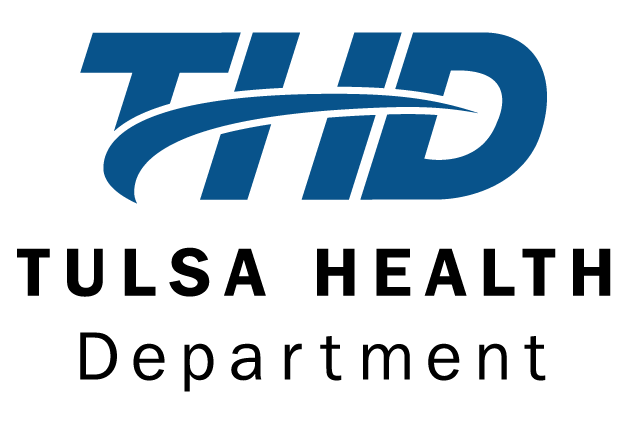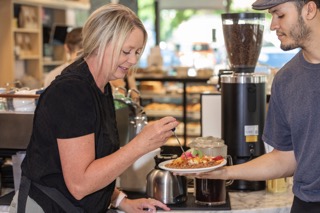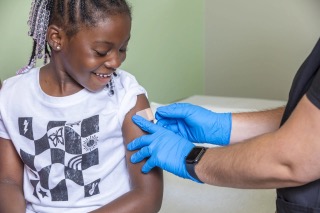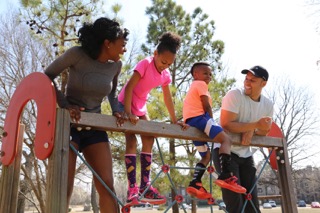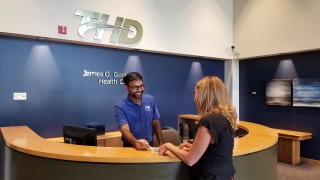Parents have so many questions about how to keep their children safe during the COVID-19 pandemic: Is it safe to attend school in person? (It depends.) What about playing sports? (It depends.) Should my child get a flu shot? (Yes.)
Holiday celebrations will likely need to be different this season to prevent the spread of the virus that causes COVID-19. Avoid activities that are higher risk for spread. Consider fun alternatives that pose lower risk of spreading the virus that causes COVID-19.
The CDC has issued guidelines for Halloween, but the level of safety for any activity depends on local conditions. The Tulsa Health Department’s zip code risk map will help you determine the risk in your neighborhood.
“Public health puts the safety of their community first,” said THD Executive Director, Dr. Bruce Dart. “We can’t always be the ‘no’ police. Halloween is an example of something that can still be fun for kids and families, as long as people follow the same general recommendations of wearing masks, watching your distancing, washing your hands and avoiding crowds and indoor events.”
Here are a few guidelines that identifies some activities that are safe (celebrating at home), less safe (careful trick-or-treating) and unsafe (big crowds). This is not intended to be a comprehensive guide for a safe Halloween: Parents and adults should review the CDC guidelines, follow the advice of public health and talk to other families to see how they plan to balance fun and safety.
Safe: Celebrate at home
Carving or decorating pumpkins with members of your household and displaying them
Carving or decorating pumpkins outside, at a safe distance, with neighbors or friends
Decorating your house, apartment, or living space
Doing a Halloween scavenger hunt where children are given lists of Halloween-themed things to look for while they walk outdoors from house to house admiring Halloween decorations at a distance
Having a virtual Halloween costume contest
Having a Halloween movie night with people you live with
Having a scavenger hunt-style trick-or-treat search with your household members in or around your home rather than going house to house
Less Safe: Careful Celebration outside the home
Participating in one-way trick-or-treating where individually wrapped goodie bags are lined up for families to grab and go while continuing to social distance (such as at the end of a driveway or at the edge of a yard)
If you are preparing goodie bags, wash your hands with soap and water for at least 20 second before and after preparing the bags.
Having a small group, outdoor, open-air costume parade where people are distanced more than 6 feet apart
Attending a costume party held outdoors where protective masks are used and people can remain more than 6 feet apart
A costume mask (such as for Halloween) is not a substitute for a cloth mask. A costume mask should not be used unless it is made of two or more layers of breathable fabric that covers the mouth and nose and doesn’t leave gaps around the face.
Do not wear a costume mask over a protective cloth mask because it can be dangerous if the costume mask makes it hard to breathe. Instead, consider using a Halloween-themed cloth mask.
Going to an open-air, one-way, walk-through haunted forest where appropriate mask use is enforced, and people can remain more than 6 feet apart
If screaming will likely occur, greater distancing is advised. The greater the distance, the lower the risk of spreading a respiratory virus.
Visiting pumpkin patches or orchards where people use hand sanitizer before touching pumpkins or picking apples, wearing masks is encouraged or enforced, and people are able to maintain social distancing
Having an outdoor Halloween movie night with local family friends with people spaced at least 6 feet apart
If screaming will likely occur, greater distancing is advised. The greater the distance, the lower the risk of spreading a respiratory virus.
Lower your risk by following CDC’s recommendations on hosting gatherings or cook-outs.
Unsafe: Beware of
Participating in traditional trick-or-treating where treats are handed to children who go door to door
Having trunk-or-treat where treats are handed out from trunks of cars lined up in large parking lots
Attending crowded costume parties held indoors
Going to an indoor haunted house where people may be crowded together and screaming
Going on hayrides or tractor rides with people who are not in your household
Using alcohol or drugs, which can cloud judgement and increase risky behaviors
Traveling to a rural fall festival that is not in your community if you live in an area with community spread of COVID-19
During the celebration
Follow these tips to reduce your risk of being exposed to, getting or spreading COVID-19 during the celebration:
Social distance and limit close contact
Maintain a distance of at least 6 feet or more from people you don’t live with. Be particularly mindful in areas where it may harder to keep this distance, such as restrooms and eating areas.
Avoid using restroom facilities at high traffic times, such as at the end of a public event.
Avoid busy eating areas, such as restaurants during high volume mealtimes, if you plan to eat out at a restaurant.
Minimize gestures that promote close contact. For example, do not shake hands, elbow bump, or give hugs. Instead wave and verbally greet others.
Wear masks
Wear a mask at all times when around people who don’t live in your household to reduce the risk of spreading the virus.
Avoid singing, chanting, or shouting, especially when not wearing a mask and within 6 feet of others.
Do not use costume masks in place of cloth masks
Do not use a costume mask as a substitute for a cloth mask unless it is made of two or more layers of breathable fabric that covers your mouth and nose and doesn’t leave gaps around your face.
Do not wear a costume mask over a cloth mask because it can be dangerous if the costume mask makes it hard to breathe. Instead, consider using a Halloween-themed cloth mask.
Limit contact with commonly touched surfaces or shared items
Clean and disinfect commonly touched surfaces and any shared items between use when feasible. Use EPA-approved disinfectants.
Use touchless garbage cans if available. Use gloves when removing garbage bags or handling and disposing of trash. Wash hands after removing gloves.
Wash hands
Wash your hands often with soap and water for at least 20 seconds, especially after you have been in a public place, or after blowing your nose, coughing, or sneezing. If soap and water are not readily available, use a hand sanitizer that contains at least 60% alcohol. Cover all surfaces of your hands and rub them together until they feel dry.
Keep safe around food and drinks
Currently, there is no evidence to suggest that handling food or eating is associated with directly spreading COVID-19. It is possible that a person can get COVID-19 by touching a surface or object, including food, food packaging, or utensils that have the virus on it and then touching their own mouth, nose, or possibly their eyes. However, this is not thought to be the main way that the virus is spread. Remember, it is always important to follow good hygiene to reduce the risk of illness from common foodborne germs.
Make sure everyone washes their hands with soap and water for 20 seconds before and after preparing, serving, and eating food. Use hand sanitizer with at least 60% alcohol if soap and water are not available.
Instead of potluck-style gatherings, encourage guests to bring food and drinks for themselves and for members of their own household only.
Limit people going in and out of the areas where food is being prepared or handled, such as in the kitchen or around the grill, if possible.
Wear a mask while preparing or serving food to others who don’t live in your household.
If serving any food, consider having one person serve all the food so that multiple people are not handling the serving utensils.
Use single-use options or identify one person to serve sharable items, like salad dressings, food containers, plates and utensils, and condiments.
Avoid any self-serve food or drink options, such as buffets or buffet-style potlucks, salad bars, and condiment or drink stations. Use grab-and-go meal options, if available.
If you choose to use any items that are reusable (e.g., seating covers, tablecloths, linen napkins), wash and disinfect them after the event.
Look for healthy food and beverage options, such as fruits and vegetables, lean proteins, whole grains, and low or no-calorie beverages, at holiday gatherings to help maintain good health.
People who should not attend in-person holiday celebrations
People with or exposed to COVID-19
Do not host or participate in any in-person festivities, if you or anyone in your household
Has been diagnosed with COVID-19 and has not met the criteria for when it is safe to be around others
Has symptoms of COVID-19
Is waiting for COVID-19 viral test results
May have been exposed to someone with COVID-19 in the last 14 days
Is at increased risk of severe illness from COVID-19
People at increased risk for severe illness
If you are at increased risk of severe illness from COVID-19, or live or work with someone at increased risk of severe illness, you should
Avoid in-person gatherings with people who do not live in your household.
Avoid larger gatherings and consider attending activities that pose lower risk (as described throughout this page) if you decide to attend an in-person gathering with people who do not live in your household.
After the celebration
After attending a gathering, individuals should monitor themselves for symptoms for 14 days and contact their health care provider if symptoms develop.
Be alert for symptoms by watching for fever, cough, shortness of breath, or other symptoms of COVID-19.
Especially important if you are running essential errands, going into the office or workplace, and in settings where it may be difficult to keep a physical distance of 6 feet.
Take your temperature if symptoms develop.
Don’t take your temperature within 30 minutes of exercising or after taking medications that could lower your temperature, like acetaminophen.
Follow CDC guidance if symptoms develop.
Tulsa County residents should schedule a COVID-19 test within 5-7 days after attending a large event. To schedule a test, contact your healthcare provider or review one of the many opportunities to be tested in Tulsa County. Even if given a negative result, it remains important to continue to monitor health for the full 14 days because individuals could still test positive later from exposure at the event or even be exposed some other place. An epidemiological investigation including contact tracing will be completed on all confirmed positive cases in Tulsa County residents by the Tulsa Health Department.
Recommendations attributed to CDC, de Beaumont Foundation and OSDH
